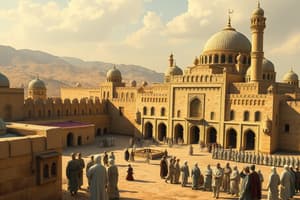Podcast
Questions and Answers
What was a significant function of Baghdad during the caliphate period?
What was a significant function of Baghdad during the caliphate period?
- It was the birthplace of major religious texts.
- It served as a center for politics, trade, and learning. (correct)
- It was primarily a military stronghold.
- It operated mainly as a cultural exchange hub without political significance.
Which caliph is known for designing Baghdad as a round city?
Which caliph is known for designing Baghdad as a round city?
- Al-Mansur (correct)
- Al-Mutawakkil
- Al-Rashid
- Al-Mahdi
What was the primary language used to record the cultural and scientific achievements in the Islamic world?
What was the primary language used to record the cultural and scientific achievements in the Islamic world?
- Arabic (correct)
- Turkish
- Latin
- Persian
Which of the following areas experienced significant advancements due to the Islamic scholarly activities?
Which of the following areas experienced significant advancements due to the Islamic scholarly activities?
What was a key achievement of Al-Rashid's support for the translation movement?
What was a key achievement of Al-Rashid's support for the translation movement?
What is the holy book of Islam that contains revelations from God?
What is the holy book of Islam that contains revelations from God?
The Hijrah refers to the migration of Muhammad and his followers from Medina to Mecca.
The Hijrah refers to the migration of Muhammad and his followers from Medina to Mecca.
Who is recognized as the prophet of Islam?
Who is recognized as the prophet of Islam?
The pilgrimage to Mecca that is encouraged in Islam is known as the ______.
The pilgrimage to Mecca that is encouraged in Islam is known as the ______.
Match the following Islamic concepts with their meanings:
Match the following Islamic concepts with their meanings:
Flashcards are hidden until you start studying
Study Notes
The Islamic World
-
The Islamic world, during the time of the caliphs, expanded significantly across Asia, North Africa, and Europe.
-
The Tigris River played a crucial role as a transportation route, connecting the Persian Gulf to Central Asia.
-
Baghdad, a strategically located city, became a major hub for political, commercial, and scholarly activities.
-
Designed by Caliph Al-Mansur, Baghdad was constructed as a circular city with a mosque and palace at its core.
-
Caliph Al-Rashid’s patronage of the Greek-Arabic translation movement facilitated the transfer of classical knowledge from Greece and Rome to later periods of learning.
-
Arabic, the unifying language of Arabia, served as the medium for recording cultural and scientific achievements.
-
Islamic scholars gathered knowledge from conquered territories, translated these materials into Arabic, and made new discoveries.
-
Prominent centers of learning emerged throughout the Islamic territory, including Cordoba, Qayrawan, Cairo, and Kufa.
-
The Abbasid dynasty played a significant role in fostering advancements in mathematics, astronomy, physics, optics, and medicine.
-
The Islamic world preserved ancient Iranian and Indian knowledge, while also connecting the ancient Greek and Roman discoveries to later learning in Medieval and Renaissance Europe.
Key Figures and Concepts
- Muhammad: The prophet of Islam. Received revelations from God, forming the basis of the Quran, faced opposition in Mecca, and migrated to Medina in 622 CE (Hijrah).
- Quran: The holy book of Islam. Contains revelations from God to Muhammad.
- Islam: A monotheistic religion based on the belief in one God (Allah) and the teachings of Muhammad.
- Muslims: Followers of Islam.
- Hijrah: The journey of Muhammad and his followers from Mecca to Medina in 622 CE. This event marked the beginning of the Islamic calendar.
- Hadith: Accounts of Muhammad's sayings and actions, second to the Quran in importance. Provides guidance on Islamic practice and beliefs.
- Hajj (Pilgrimage): A pilgrimage to Mecca, strongly encouraged in Islam. It is one of the five pillars of Islam.
- Bedouin: Nomadic Arabs living in the deserts of Arabia. Played a significant role in the early spread of Islam.
The Rise of Islam
- Muhammad received revelations from God, forming the basis of the Quran. The Quran is considered the literal word of God and is the central text of Islam.
- Faced opposition in Mecca. Muhammad and his followers migrated to Medina in 622 CE (Hijrah), establishing a community of Muslims.
- Gained political and military influence, uniting the early Muslim community.
- After Muhammad's death, early accounts of his teachings and actions were collected and codified as Hadith. These writings provide further insights into Islamic practice and beliefs.
Important Locations
- Mecca (Makkah): The holiest city in Islam, containing the Kaaba, a sacred shrine. The Kaaba is a cube-shaped building that Muslims circumambulate during the Hajj.
Key Points about Islam
- Emphasizes submission to God's will. Muslims believe in surrendering to the will of Allah.
- The Quran provides guidance and principles for living a righteous life. It covers various aspects of life, including faith, law, morality, and social behavior.
- The Hadith offers further insights into Islamic practice. These accounts of Muhammad's life provide practical examples and context for understanding the Quran.
- The pilgrimage (Hajj) to Mecca is strongly encouraged. It is one of the five pillars of Islam, symbolizing the unity of Muslims and their devotion to God.
Studying That Suits You
Use AI to generate personalized quizzes and flashcards to suit your learning preferences.




